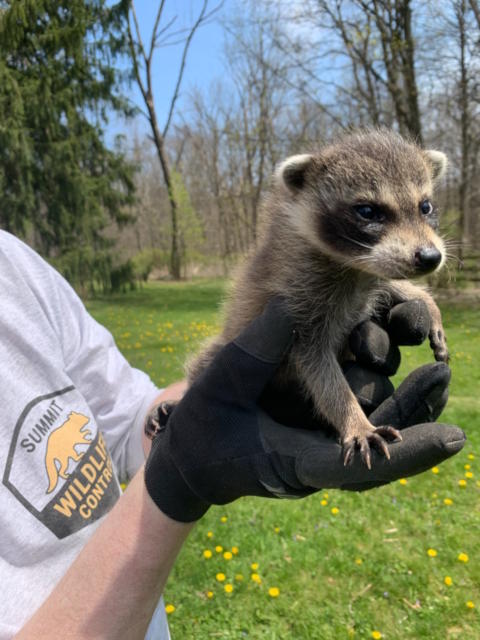Late March through early April is a special — and possibly very stressful — time for homeowners in Ohio. This is the time of year raccoons give birth to their young. Quite often baby raccoons are born in the attics, crawlspaces, and seemingly unreachable voids of residential homes and commercial buildings.

Mother raccoons give birth to a litter of 3 to 7 young (called kits). Newborn raccoons are born with fur, and their eyes open in about 3 weeks. After 7 or 8 weeks young raccoons are weaned and weigh about 1.5 pounds. But even after being weaned, juvenile raccoons stay with their mother into the fall, sometimes staying with her through their first winter. If you see a group of raccoons walking together it is probably a mother and her juvenile young. Raccoons can breed after one year of age, with females generally having a single litter annually with an average of four kits.
Here in Ohio, wildlife control operators (WCOs) begin to receive reports of baby raccoons in March and April. Often times homeowners describe non-stop scratching and “chittering” sounds coming from somewhere in the home. This is almost always a sign of baby raccoons in the attic or crawlspace.
So how should you handle the problem of baby raccoons in the home? Unfortunately, the answer is “it depends.” Removing a family of raccoons can be stressful and costly. Additionally, the removal process can lead to more damage than the raccoons have already caused. Start by taking a deep breath and asking yourself a few questions.
Deciding What to Do About Baby Raccoons
“Why do I need the raccoons removed?” In most cases the damage caused by a female raccoon and her litter of young is minimal. The majority of raccoon damage occurs when the animals overwinter in your attic. Females giving birth in your attic are in most cases only there short term. Typical damage includes a small area of soiled insulation, with minimal damage to the soffit or eaves of the home. This damage has already taken place by the time you discover the raccoons.
“How long will they be there?” Baby raccoons will be weaned in approximately 8 weeks. Once they can walk, following their mother outside to learn the ways of being a raccoon, you can safely evict them without further damage to the home. Most times, the mother raccoon will move the family out of your home on her own.
“Can I just trap the mother?” Trapping the mother is an option, but in Ohio a trapped raccoon can not legally be relocated. This means the mother must be euthanized, dooming the young to either die a slow death in the attic or they will need to be removed by hand and euthanized, as well.
“Is there a way to remove them humanely?” Yes, there is! A competent WCO can retrieve the baby raccoons, placing them outside of the home in a raccoon “baby box”. As a result, the cries from the young will cause the mother raccoon to leave the den to fetch her babies — usually after dark — and relocate them to an alternate den site. At this point, seal the entrance and start home repairs.
When dealing with baby raccoons, your health and safety should come first. Never handle baby raccoons without gloves, and never attempt to evict a litter of kits in a way that would provoke the mother raccoon to defend her young. For your safety and sanity, we recommend that you call a competent wildlife control service that uses humane methods to remove the raccoons from your home.





